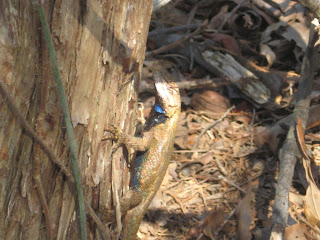Today was notable for a finally being hot and sunny on the immediate coast- temperatures soared to the high seventies/eighty realm (amen!), and for an influx of new avian arrivals.
House Wrens were singing their rich liquid cascading song from many a tangle and hedge this morning where yesterday there were none. Little flocks of dapper Chipping Sparrows were in evidence on favored lawns, Ruby-crowned Kinglets were singing their way-too-big-for-that-size-bird song, and where the last week there has been one Common Yellowthroat, today, many a likely patch of Cattails had its own resident wichity-witcher.
And as I mentioned above, good things apparently come in packages of seven.
A quick look on the beach at South Cape May, revealed no gulls, which is odd, except for a group of seven, dark, long-winged streamlined beasts all together, and feeding in the surf line like wintering Willets. Yes you guessed it, the only gulls on the beach were a flock of seven Lesser Black-backed Gulls. Time was (and a time I can remember) when a birder would travel a couple of hours to see this European stray. Now one can find dozens (rarely hundreds) at certain favored reservoirs and roosting sites. In Cape May, the most I've ever seen was twenty seven. These seven were the most I've seen or heard of in these parts this year. All were under two years old, and it is worth noting that there has been a shift in the timing of records around here too. They used to be a quite rare cold-season phenomenon, and largely unheard of during summer, while now they are much more expected and numerous during the warmer months, and far rarer in the colder months. You should see at least one Lesser Black-back a day on the beach in Cape May from April through October these days, usually more.
 |
| Seven immature Lesser Black-backed Gulls on the beach at South Cape May |
 | ||
| Seven Stilt Sandpipers on Bunker Pond |
And while Higbee's Beach did hold some nice birds (as always!) including the first female Prairie Warbler I've seen this year, it was the little creatures enjoying the afternoon sun that caught my attention there.
Such as this Blister, or Oil Beetle. These relatively large (about as long as the distal two thirds of my index fingers, if that helps you at all), sluggish, flightless, and conspicuous insects have the advantage that many sluggish, flightless, and conspicuous meal-sized creatures have going for them. They employ chemical warfare as a defense against the hungry. They get their name from a yellowish orange toxic oil they secrete when molested, which causes a blistering burning reaction and is apparently unpleasnt enough to allow the beetles to wander around in broad daylight, in flagrante delecto with no worries. Immodest as that may be.
 |
| Meloe sp. Note the reduced elytra-they protect no wings beneath |
 | |||
| Meloe sp. Higbee's Beach, Cape May, NJ |
The edges of permanent ponds and the few ditches which still hold water in this year of drought (NJ just entered its fourth month of below-average rainfall. One sees dust devils where one should be wearing wellies...oi.) held a few Northern Cricket Frogs (Acris crepitans). Cricket Frogs are diminutive frogs-this one ranges from 5/8 of an inch to 1 3/8, with a big voices. An average Northern Cricket Frog can sit comfortably on a man's thumbnail. One of the best ways to tell the Northern Cricket Frog, apart from range of course, is they usually have either a rust, or leaf-green stripe of color on their backs, which bifurcates at the head, the points of the fork going to the tops of the eyes. they also have a characteristic rough skin, short legs, and "moustaches" of little black dashes on their upper lips.
 |
| Northern Cricket Frog |
 |
| Northern Cricket Frog |
 |
| note the rust-colored stripe on the back, forking to meet the eyes |
 | ||||
| That's a bayberry leaf he's astride. As in a half inch or so wide. |
"The Voice of the Cricket Frog is a combination of a rattle and a musical clink, but is only about half as loud as that of the Spring Peeper. A chorus heard at a distance sounds like the jingling of small sleigh bells, for the musical element of its call travels farther than the rattle. A chorus heard close by sounds like the rattle of small pebbles poured upon a cement pavement...The time and rhythm of the sounds are about the same as that of the following syllables pronounced with the speed of ordinary reading: click, click, click, click...click-e-ty, click-e-ty, click-e-ty, click-e-ty, click-e-ty...cree, cree, cree, cree..."
And I found this male Northern Fence Lizard (Sceloporus undulatus hyacinthus) enjoying the sun, and heated up enough to do his push-up display, showing off his deep indigo and electric blue pecs and underside.
And finally, this handsome little thing was my first Red-banded Hairstreak of 2012. A tiny, but very dapper little butterfly. Unfortunately he flushed never to return before I could get him without the conceasling shadow of the arrow-wood viburnum he's perched upon, but you get the idea.
 |
| Red-banded Hairstreak, Higbee's Beach, Cape May, NJ |


No comments:
Post a Comment